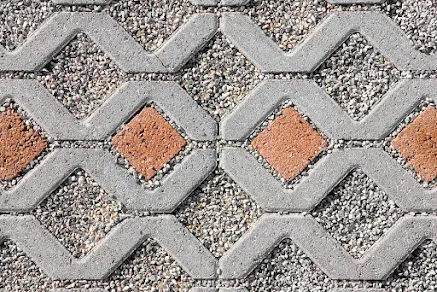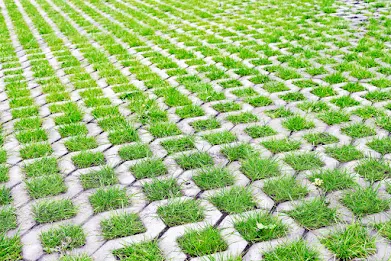What is a Permeable Patio?
A permeable patio is a type of outdoor surface designed to allow water to pass through it rather than causing runoff. This is achieved by using materials that promote the infiltration of water into the ground below, helping to manage stormwater, reduce erosion, and prevent flooding. Permeable patios are an eco-friendly and sustainable alternative to traditional impermeable surfaces, such as concrete or asphalt, which can contribute to stormwater pollution and increased strain on sewer systems.Permeable Patio Materials/Techniques
Permeable Pavers
Innovative Paver Design for Eco-Friendly Landscaping
Upgrade your outdoor space with permeable pavers, the ultimate solution for an eco-friendly yet durable driveway, walkway, or patio. Comprising materials like natural stone, concrete, or brick, these pavers are uniquely designed with small gaps to facilitate efficient water drainage without compromising structural integrity.
Structured Foundation: The Role of the Base Layer
A sturdy base layer is the first step to installing your permeable paver system. Typically constructed of compacted gravel or crushed stone, this layer not only adds structural stability but also plays a crucial role in water management, offering additional drainage pathways for rainwater.
Perfect Bedding: Coarse Sand and Permeable Aggregate
Before laying down your eco-friendly pavers, a bedding layer of coarse sand or permeable aggregate ensures a smooth, level surface. More than just a substrate, the bedding material maintains the essential gaps between each paver, augmenting the system's water-permeable nature.
Expert Installation: Setting Pavers for Optimal Drainage
With meticulous attention to gap maintenance, each permeable paver is placed onto the bedding layer in a specific arrangement. Sometimes, additional jointing materials or spacers are utilized to guarantee precise spacing and alignment, maximizing the paver system's drainage capabilities.
Long-Lasting Performance Through Proper Joint Filling
After setting the pavers, the gaps are filled using fine gravel, sand, or specialized joint fillers that are permeable. These fillers not only add structural support but also enhance the water drainage efficiency of your eco-friendly driveway or walkway.
Maintenance for Continuous Efficiency
To keep your permeable paver system functioning optimally, regular maintenance is key. By sweeping or vacuuming, you can prevent debris from clogging the essential gaps, ensuring your driveway or walkway remains as eco-friendly and efficient as the day it was installed.
Porous Concrete or Asphalt
Porous concrete and porous asphalt are innovative materials designed for creating hard surfaces that allow water to pass through, promoting effective drainage and reducing stormwater runoff. These materials can be used for various applications, including patios, driveways, parking lots, and walkways, and are particularly suitable for areas with high rainfall or where managing stormwater is a priority.
Porous Building Materials: The Future of Sustainable Construction
Looking for an eco-friendly solution to manage stormwater and reduce runoff? Consider porous concrete and asphalt for your next driveway, patio, or parking lot project. These innovative materials feature a unique composition that facilitates natural water drainage, making them perfect for high-rainfall areas and sustainable urban planning.
Material Makeup: Aggregate and Reduced Fine Particles
What sets porous concrete and asphalt apart are their compositions, which include aggregate mixed with either cement (concrete) or bitumen (asphalt), and fewer fine particles like sand or dust. This results in a highly porous structure with interconnected voids, allowing water to easily permeate the surface and reach the ground beneath.
Laying the Foundation: Base and Subbase Layers
Before pouring your eco-friendly porous concrete or asphalt, it's essential to prepare the base layer using permeable materials like crushed stone or gravel. These base layers not only offer stability but also contribute to the material's drainage capacity. Optionally, a permeable subbase layer can be added for enhanced water management.
Installation Process: Special Techniques for Porosity
Unlike standard concrete or asphalt, porous versions require specialized installation techniques to maintain their water-permeable structure. Whether it's choosing the right mix design, adjusting the curing process, or employing specific compaction methods, attention to detail is key in preserving the integrity of these eco-friendly materials.
Natural Infiltration: Minimizing Stormwater Runoff
Once in place, porous concrete and asphalt offer superior stormwater management. Rainwater infiltrates the surface and passes through the prepared base and subbase layers. This natural infiltration process minimizes runoff, reduces the need for stormwater infrastructure, and can even contribute to groundwater recharge.
Maintenance Essentials: Keep It Porous
Maintaining the performance of your porous surface is crucial. Regular sweeping, vacuuming, or even occasional pressure washing—although not ideal for water conservation—helps keep the pores clear. Periodic inspections for wear and tear are also recommended to ensure the material's long-lasting efficiency.
Gravel or Crushed Stone
Gravel: The Affordable, Versatile Choice for Permeable Patios
If you're searching for a budget-friendly and eco-conscious material for your permeable patio, gravel should be at the top of your list. Composed of naturally occurring small stones and rock fragments, gravel is as versatile as it is affordable. The installation process starts with a foundational layer of compacted aggregate or sand, followed by a 2-4 inch layer of gravel, perfectly suited for natural landscape integration.
Crushed Stone: Enhanced Stability Through Angular Particles
Similar to gravel but unique in its own way, crushed stone is mechanically engineered from larger rocks, leading to angular pieces that interlock for superior stability. Available in a range of sizes and colors, crushed stone makes a robust choice for permeable patios. Like gravel, the preparation involves laying a base layer of compacted aggregate or sand, followed by the crushed stone layer.
Decomposed Granite: A Cohesive, Natural-Looking Option
As a byproduct of granite weathering, decomposed granite offers a fine, sandy texture and a cohesive look. This material, usually golden to reddish-brown, adds a touch of elegance to any outdoor space. The installation process is similar to that of gravel and crushed stone—beginning with a base layer of compacted aggregate or sand, topped by the decomposed granite. For enhanced permeability and durability, the decomposed granite layer can be stabilized with natural resins or polymers.
Turf Pavers or Groundcover Grid Systems
For those keen on merging durability with eco-friendliness, turf pavers offer a compelling solution. These grid systems are made of sturdy materials like plastic or concrete, providing a robust framework for soil and vegetation. The grid system adds stability, making it safe for foot traffic and patio furniture, yet is porous enough to facilitate natural water drainage.
Groundcover Grid Systems: A Natural Choice for Sustainable Living
As an alternative to grass, I strongly recommend opting for groundcover plants in these grid systems for multiple eco-friendly advantages. These low-maintenance plants promote water conservation and minimize soil erosion, while also adding visual charm to your outdoor space.
The Perks of Permeable Patios: A Seamless Blend of Functionality and Aesthetic Appeal
Permeable patios don't just score high on the environmental front; they also offer substantial aesthetic benefits. When carefully designed with the right materials, these patios can seamlessly integrate into any sustainable landscape, offering a stylish yet functional area for outdoor relaxation and entertainment.
Essential for Sustainable Landscaping
By embracing groundcover grid systems or turf pavers, homeowners can achieve a win-win situation: enjoying a beautiful, functional space while fulfilling their ecological responsibilities. These systems are the epitome of sustainability, adding a new layer of practicality and aesthetic pleasure to modern outdoor living.


No comments:
Post a Comment